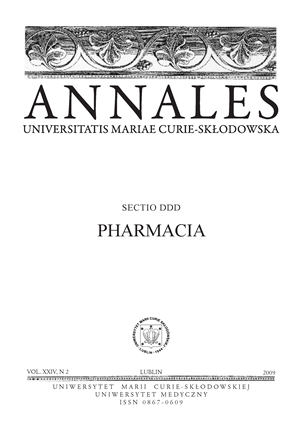Evaluation of pH influence on in vitro permeation of salicylic acid,ephedrine and L-tyrosine through porcine pericardium
DOI:
https://doi.org/10.2478/v10080-008-0185-8Abstract
In the present paper we decided to study porcine pericardium permeation of simple compounds having similar molecular weights under various pH conditions enabling diffusion of all the forms: free base or cation (ephedrine), free acid or anion (salicylic acid) and cation, inner salt or anion (L-tyrosine). A standard Franz-type diffusion cell was used for all the experiments. Slices of frozen pericardium were thawed and attached immediately between two halves of the cell. Acceptor chambers were previously filled with the same medium as donor ones without penetrating the chemical. Donor chambers were filled with solution of studied chemicals at desired pH. The system was then transferred into the mechanical shaker, the samples were withdrawn and analysed using Specord UV-VIS spectrophotometer. We found that (contrary to commonly accepted predictions) ionised forms of salicylic acid and ephedrine penetrated faster than their nonionised forms; however, the differences were really small. All the forms penetrated considerably faster (especially ephedrine) than all the hormones studied so far (60%-80 % vs 16%-54%). In the case of L-tyrosine its cationic form showed the best diffusional properties, anionic form penetrated more slowly while inner salt was the worst penetrant. The observed values cover almost the same range (17%–48%) as we determined before for peptide hormones. The penetration pattern of peptides can be complicated by their amino acids composition and sequence that affects pH dependent behaviour of the molecule as the pK values of different amine acids are not the same. The molecule shape can also play some role. Therefore, it seems that only experimental studies are able to show precisely how fast the penetration is and how the pH value of the donor medium affects the penetration pattern. From all the studies we concluded that peptides are expected to diffuse more slowly than smaller compounds such as salicylic acid and ephedrine, but within the same range as L-tyrosine. The observed penetration rate may mainly depend on pH of the donor medium – cationic forms should penetrate faster than anionic ones, while at isoelectric point the penetration rate should reach its minimal value. Therefore, pH of the donor medium can be regarded as the most important factor.
References
1. Bialik W., Dolińska B., Suszka-Świtek A., Ryszka F., Wojtynek M.: Evaluation of in vitro prolactine permeation through porcine pericardium in the presence of tensides. Annales UMCS, Sect. DDD, 18, 79, 2005.
2. Bialik W., Dolińska B., Suszka-Świtek A., Ryszka F., Wojtynek M.: Evaluation of in vitro permeation of chosen peptide hormones through porcine pericardium in the presence of tensides. Annales UMCS, Sect. DDD, 19, 23, 2006.
3. Friend D. R.: In vitro skin permeation techniques. J. Cont. Release, 18, 235, 1992.
Downloads
Published
Issue
Section
License
Copyright (c) 2009 Authors

This work is licensed under a Creative Commons Attribution-NonCommercial-NoDerivatives 3.0 Unported License.


